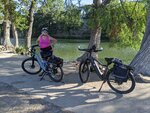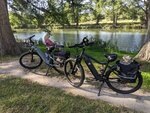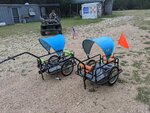bob armani
Well-Known Member
Hi guys! This is a special topic for me, and I wanted to share my story here, because I have a physical limitation when it comes to knee health. I grew up in Colorado with a family that would go hiking and skiing frequently. I'm so thankful for those special times and have grown to love the outdoors, but years of strain and some especially hard landings and moguls has left me hurting. Listed below are some of the challenges I face in everyday life and how I deal with them. I hope this helps others and I welcome your feedback and stories as well
- Cycling is fun, but longer rides and jumps can activate my knees. I had knee issues before I began commuting to work, but I figured that cycling was going to be one of the easiest activities for my knees... It wasn't until I was riding 5+ miles each day (up and down some hills) that I began to experience pain. Cycling seems so much smoother and less jarring than walking, running, or hiking... but the repetitive knee bending motion and resulting imbalance of leg muscles can cause a sharp pain in both of my knees. This is actually why I started ElectricBikeReview.com and part of what makes electric bikes so cool and special for me. Even with an ebike, I start slowly or rely on a throttle in some situations. Torque sensors and advanced multi-sensors are my favorite type of motor controller now (compared to cadence sensors) because they don't require me to pedal hard to get the bike going from standstill. Sometimes I get excited and stand up for jumps or bumpy mountain biking sections... but that can also activate my knee, so I almost always prefer a full suspension ebike to a non-suspension. One of my favorite electric bikes to own (for city riding and trail/mountain use) was the Easy Motion Neo Jumper, which did have a throttle as well as torque sensing assist. Most eMTB products now only offer pedal assist so that they can be classified as Class 1 and go on more trails. This is alright in many ways, because companies like Bosch, Brose, Yamaha, and Shimano have created torque sensors that activate near-instantly. I especially like the Bosch Performance Line CX on eMTB mode, the Brose S, and Yamaha PWX. I also prefer the lightest electric bikes I can find because that makes them easier to start and handle (as well as lift). I'm not a really large, heavy, or strong person (even though I work out regularly doing lightweight leg press, leg extension, and calf exercises with machines). Below is a video comparing some of the different electric mountain bike motors back to back. Easy Motion no longer sells the NEO Jumper model and the new EVO Jumper doesn't come with a throttle. One approach to finding a full suspension electric mountain bike is to build your own using an ebike kit.
In closing, one of the other ways that I support my knees is to take Glucosamine Chondroitin & MSM daily supplements. This dietary supplement is a joint complex meant to support daily joint use and it seems to reduce my pain. The only downside to my exercises, stretches, avoidance of overuse, and supplement intake is that I start to feel normal and forget that my knees are still vulnerable. Just this morning in fact, an ebike arrived for me to review and hurt my knee trying to lift the box and drag it around a corner into the garage. I've found that walking backwards is easier than forwards when doing stairs or lifting and pulling objects like this... Anyway, I hope that this helps you and I welcome input about foam roller for IT band stiffness or other tips and tricks to deal with knee issues or sensitivity.
- Stairs are difficult for me, I almost always walk backwards and hold onto the railing. If I don't do this, my left knee will start hurting... I used to race up and down stairs, taking two at a time! When I was in middle school, learning how to skateboard, I would ollie off of stairs and sometimes jump and spin down. There were moments that I fell or twisted and experienced pain, but I figured that those hurts would heal like a bruise. Now, I'm one of the people who really appreciates ramps and takes my time with each stair.
- Hiking is fun, but mostly on the way up, and I always use hiking poles and neoprene knee braces. I used to trail run and be one of the first people in my family to make it back to the car, going down was the easy part! I have found now, due to my knee sensitivity, that climbing or flat sections are the most comfortable. I always wear supportive hiking boots and don't bang my knees when going down slopes like I used to, I've learned how to support my knees by stepping on the pads of my feet vs. heel first.
Wow Court I had no idea you were dealing with knee issues to this extent. I hope you recover in some way, perhaps with new technology in knee surgery or other devices some genius will develop in this field. I myself have taken some pretty hard falls, but fortunately have recovered with persistent physical therapy techniques and daily exercise regimens that help a lot. I have been cycling for over 40 years and I yet to ever consider getting a professional bike fitting. Every bike purchase since I was 10 yr old was grab and ride right out of the dealership. Well, I have owned countless bikes over the years and have had many of the classic symptoms related to biking (numbness/tingling in the fingers and hands, lower back pain, etc, however my knees seem to be fine. The correct bike gloves helped immensely and an adjustable stem for better positioning as well. I have just purchased a new E-bike, however, I have not been fitted by a professional, however, after reading this thread, I am now considering it.
My question to anyone: Is a fitting really necessary, and if so, how comprehensive does it need to be? What is considered a good and thorough fitting at a qualified shop? Any suggestions deeply appreciated. Thanks in advance!



